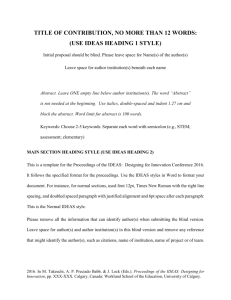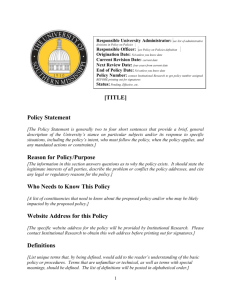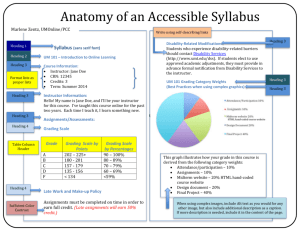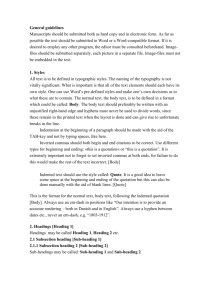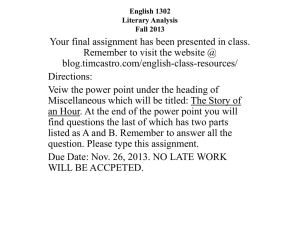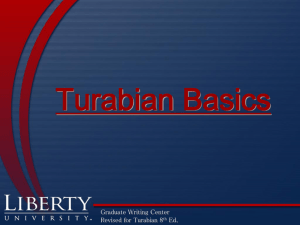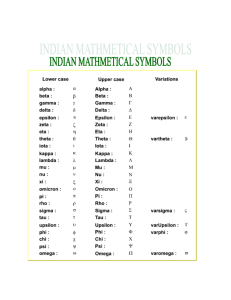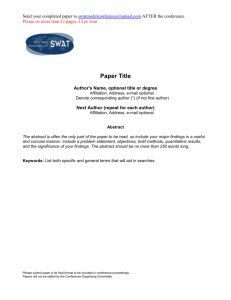TCA College Turabian Template
advertisement
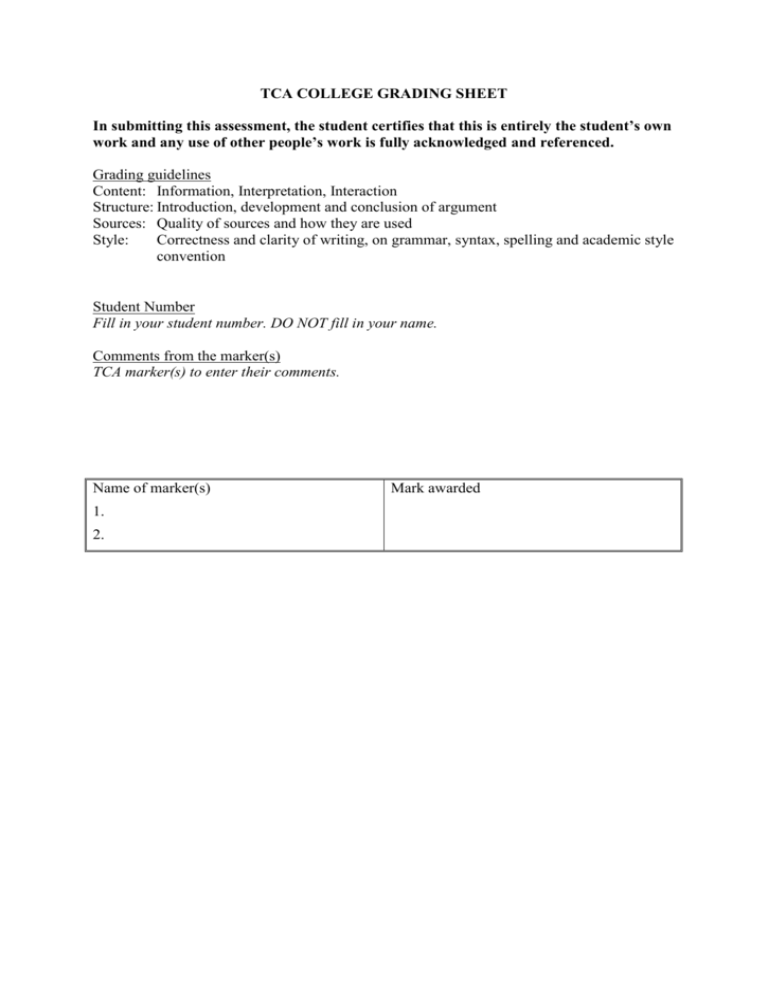
TCA COLLEGE GRADING SHEET In submitting this assessment, the student certifies that this is entirely the student’s own work and any use of other people’s work is fully acknowledged and referenced. Grading guidelines Content: Information, Interpretation, Interaction Structure: Introduction, development and conclusion of argument Sources: Quality of sources and how they are used Style: Correctness and clarity of writing, on grammar, syntax, spelling and academic style convention Student Number Fill in your student number. DO NOT fill in your name. Comments from the marker(s) TCA marker(s) to enter their comments. Name of marker(s) 1. 2. Mark awarded TCA COLLEGE PUT YOUR TITLE HERE (ALL CAPS) A PAPER SUBMITTED TO LECTURER OF THE COURSE IN PARTIAL FULFILLMENT OF THE REQUIREMENTS FOR MODULE NUMBER AND NAME OF MODULE BY STUDENT NUMBER (DO NOT INCLUDE NAME) SINGAPORE DATE OF SUBMISSION CONTENTS INTRODUCTION (HEADING LEVEL 1) ...............................................................................1 FIRST MAJOR POINT (HEADING LEVEL 1) .......................................................................2 First Subpoint (HEADING LEVEL 2) .................................................................................. 3 Second Subpoint (HEADING LEVEL 2) .............................................................................. 4 Second level first subpoint (HEADING LEVEL 3) ........................................................... 5 Second level second subpoint (HEADING LEVEL 3) ...................................................... 5 SECOND MAJOR POINT (HEADING LEVEL 1) ..................................................................6 First Subpoint (HEADING LEVEL 2) .................................................................................. 6 Second Subpoint (HEADING LEVEL 2) .............................................................................. 6 CONCLUSION (HEADING LEVEL 1) ...................................................................................6 BIBLIOGRAPHY (HEADING LEVEL 1) ...............................................................................8 ii INTRODUCTION (HEADING LEVEL 1) The layout of this paper is for a paper length of less than twenty-five pages. If your paper exceeds twenty-five pages, you should format it according to chapter headings. Please consult your lecturer on the precise format. For an assessment that is less than five pages, a contents page is not necessary. A bibliography page is necessary for all assessments. The introduction of your paper should be no more than one page in length. It can go a little over, but please make it as succinct as possible. All you need to do here tell your reader generally what you are covering. You may also need to explain that the topic is bigger than can be handled in just ten pages, so you are only going to deal with specific aspects of your topic. Make sure your introduction does not say that you are going to cover something if you forgot to actually mention that in your paper. Although you may write your introduction first as you think about your topic, you should make sure that you go back and re-read it to make sure it does tell the reader what you are covering and no more. The best thing is to write the introduction last so that you can then describe exactly what you already wrote in your paper. The Major Heading title is your first level heading (Heading 1) and usually centered. The “Styles” feature in Microsoft Word can help you format this quite easily but you can follow the style in this paper. The font size in used for all text including headings is Times New Roman, 12 point, and double-spaced. Do not use any other font. If you need to use Greek, Hebrew or French in your paper, you may use transliteration of 12 point size such as agape, or samayim. Please only use the original or modern languages if you know them well. Quoting a Greek or Hebrew word does not mean anything to the paper. Notice that the margins are one-inch all round. The footnote number should be outside the margins as shown below. The contents page is the second page (following the title page) and that is the reason for numbering it page ii, in Roman numerals. The main paper should 1 begin with Arabic numerals and set Times New Roman, 12 point size. Footnotes will be Times New Roman, 10 point size, with a 0.5 inch indent as seen below.1 Each footnote shall be separated by a single line spacing.2 All main text including the footnotes is included in the final word count. The cover page and the bibliography are not included in the word count. FIRST MAJOR POINT (HEADING LEVEL 1) However many sections you have, each one should have its major heading which is formatted with the “Heading 1” style. If your major heading happens to be lengthy, it will need to be set in two or more lines. Introduce what you are going to say in this section then start to make your argument. Notice that each paragraph of text is at least three lines or more. If you are going to use biblical references, notice how the footnote is done to ensure your cite from a normal version, in case you want to cite from different versions. For example, the first time you refer to a biblical text, say Isaiah 40:3, footnote like this below.3 Notice that the book “Isaiah” is spelt in full, but you should abbreviate in when it appears in parenthesis (e.g. Isa. 40:3).4 Please follow Turabian’s way of abbreviations and citation.5 1 TCA School of Theology uses the Turabian Style Guide. Refer to chapter 17 of Kate L. Turabian, A Manual for Writers of Research Papers, Theses, and Dissertations: Chicago Style for Students and Researchers, 7th ed. (Chicago: University of Chicago Press, 2007), 160–215, on to proper cite your sources. Note the capitalization of the nouns, but not the conjunctions and prepositions above. We also recommend you to use Zotero (www.zotero.org) as a bibliographic manager to manage your sources and help in your citations. 2 Ibid., 373–408. Note how “ibid” is used for the second time we reference the same book immediately following. 3 All biblical quotations will be from the New American Standard Version unless otherwise noted. 4 Bo H. Lim, “The ‘Way of the Lord’ in the Book of Isaiah” (Ph. D Dissertation, Deerfield, IL: Trinity Evangelical Divinity School, 2006). We inserted a dissertation here on the book of Isaiah to show you how it is done as well. Note the way the last name is the surname in our Asian context. 5 See a full list in Turabian, A Manual for Writers, 331–346. Notice how we cite this source again using a shorter title, because it was interrupted by a different source at note 4. 2 First Subpoint (HEADING LEVEL 2) The sub point of your first major point should have a different style (Heading 2) from the first. There should be a space before the previous text. You must have at least two sub points; it does not make sense if there is only one sub point. Now, let us discuss how you should do quotations. If you have a short quote of less than three lines, you must put the quotation marks. For example, Andrew Hill and John Walton explain that “the labors of Ezra and Nehemiah to rebuild and reform postexilic Jerusalem were large inspired by the theological truth of Yahweh as covenant keeper (cf. Neh. 9:32).”6 Notice that the first time we used the author’s name we spell out their full names. Subsequently we can use their last name when we quote them. Hill and Walton, aver that this was in keeping with God’s covenant making nature (cf. Ps. 111:4-5, 9).7 Now for long quotes. If the quote is more than three lines then you need to put it in its own paragraph. You should also introduce the quote. Tell your reader why you are using this particular quote. For example, the Qumran text 1QS 8.12-16 reads, And when these become members of the Community in Israel according to all these rules, they shall separate from the habitation of ungodly men and shall go into the wilderness to prepare the way of Him; as it is written, Prepare in the wilderness the way of …, make straight in the desert a path of our God. This (path) is the study of the Law which He commanded by the hand of Moses, that they may do according to all that has been revealed from age to age, and as the Prophets have revealed by His Holy Spirit.8 6 Andrew Hill and John Walton, A Survey of the Old Testament, 3rd ed. (Grand Rapid, MI: Zondervan, 2009), 340. 7 Ibid., 341; Aryeh Kasher, “Synagogues as ‘Houses of Prayer’ and ‘Holy Places’ in the Jewish Communities of Hellenistic and Roman Egypt,” in Ancient Synagogues: Historical Analysis and Archaeological Discovery, ed. Dan Urman and Paul V. M. Flesher, vol. 1 (New York: Brill, 1995), 210; Terry Cross, “The Divine-Human Encounter: Towards a Pentecostal Theology of Experience,” Pneuma: The Journal of the Society for Pentecostal Studies 31, no. 1 (2009): 20; Terry Cross, “A Proposal to Break the Ice: What Can Pentecostal Theology Offer Evangelical Theology?,” Journal of Pentecostal Theology 10, no. 2 (2002): 50–51; Stanley M. Burgess, “Holy Spirit, Doctrine of: The Ancient Fathers,” in The New International Dictionary of Pentecostal and Charismatic Movements, ed. Stanley M. Burgess and Eduard M. van de Maas, rev. and exp. (Grand Rapids, MI: Zondervan, 2002), 744. We deliberated inserted a book chapter, journals and a dictionary article to show you how it is done. Do observe the way it is formatted in the bibliography. 8 Geza Vermes, The Complete Dead Sea Scrolls in English (New Haven: Penguin Books, 2012), 109. 3 If you are going to follow commenting the block quote, then there should not be any indent since it following your sentence. However, if the paragraph after the quote is a new thought then you will have to change the style back to “Body Text” so that you will get the proper indentation. Notice in the block quote above, there is what we call an ellipsis (3 periods); it is to refer to text that you either do not need to be quoted or words that are missing text.9 Second Subpoint (HEADING LEVEL 2) You should not use quotes very often. Quotes are mostly used in order to prove that someone actually thinks the way you say they think. If you want to prove that someone argued for a position that is not standard you would need to quote them as saying something in particular that proves your point. More often than not, you should simply summarize the person’s point of view or paraphrase them. This is a skill you will have to learn. But whenever you use someone else’s thoughts and ideas you have to put a footnote giving them credit. Your research paper is supposed to be a paper that is researched. This is not a paper about your own thoughts, but about what you have learned from others. So please give them credit for giving you the ideas that you use in your paper. Otherwise it is plagiarism and your professor will fail your paper which will mean that you will probably fail the class. So please give credit where credit is due by including a lot of footnotes in your paper. A good research paper would have two to five footnotes per page or maybe even more. You could easily have fifty footnotes in one ten page essay. In a ten page essay, Undergrad students should have at least five quality references in their bibliography and Masters level students should have at least ten quality 9 Turabian, A Manual for Writers, 354–358. 4 references. However, it does not mean that the more references you have, the better the paper will be. Second level first subpoint (HEADING LEVEL 3) Second level subpoints for a ten page paper is possible though not necessary. If you need to have it, you can format it differently from the rest (Heading 3) as we have done. Let us mention a few things about bibliography. The bibliography is the last page(s) in the paper and it is formatted differently. If there are two sources by the same author, replace the individual name was a long dash called a 3-em dash.10 Make sure the sources are listed alphabetically by last name of the author or editor. Second level second subpoint (HEADING LEVEL 3) We encourage students to use academic sources and especially primary sources. If you are dealing with a paper on a biblical subject, say, “The Way of Lord in the book of Isaiah,” then your primary source is the Bible (especially the Isaianic texts). If you are working on a paper dealing with church history, say “the influence of Justin Martyr,” then you should refer to Justin Martyr’s works such as Dialogue with Trypho. Secondary sources can be consulted as well, and it will do you well to cite more recent sources by which we mean less than thirty years. Rarely cite an internet source but if you need to, then follow the strict format as below.11 At no instance should you use Study Bibles, sermons, devotional commentaries or other such materials, English dictionaries such as Webster, popularity sources such as Wikipedia, etc. You should never write out your testimony in any paper, unless you are writing up a sermon for a class. When in doubt, speak with your lecturer. 10 Ibid., 148–149. See the example on Terry Cross in the bibliography. Stuart Douglas, “OT222 - Proverbs-Psalms: Singing the Sounds of Real Life,” ChristianCourses.com, n.d., http://christiancourses.com/courses/proverbs-psalms-singing-the-sounds-of-real-life (accessed April 16, 2013). For internet sites please give the date you last accessed the site. 11 5 Writing a good paper does not happen overnight. It requires much research and hardwork. We suggest that you start thinking about your topic the moment you receive your assessment, and then begin reading in that area. Produce an outline and start searching possible books, and journal articles for your paper. For a ten page essay, you may need as much as one month to write a good paper. So start early! SECOND MAJOR POINT (HEADING LEVEL 1) We include this section to show you how it is done. Again, each major point should have its major heading which is formatted with the “Heading 1” style. If your major heading happens to be lengthy, it will need to be set in two or more lines. First Subpoint (HEADING LEVEL 2) We repeated this from above. The sub point of your first major point should have a different style (Heading 2) from the first. There should be a space before the previous text. You must have at least two sub points; it does not make sense if there is only one sub point. Now, let us discuss how you should do quotations. If you have a short quote of less than three lines, you must put the quotation marks. Second Subpoint (HEADING LEVEL 2) We repeated this from above. You should not use quotes very often. Quotes are mostly used in order to prove that someone actually thinks the way you say they think. If you want to prove that someone argued for a position that is not standard you would need to quote them as saying something in particular that proves your point. CONC LUS ION (HEADING LEVEL 1) The conclusion is where you summarize your argument. This is not really the place to introduce new arguments. You may still have footnotes within this section, but do not start a 6 whole new line of thinking. Just tell your reader what you think. If you have outlined three different positions on the doctrine of the atonement, then this is now the appropriate place to give your opinion on which theory is the best. Maybe what you prefer is a combination of two of the theories but make it succinct. Like the introduction, the conclusion should not be too long. And please try to make sure your whole paper is within the word limit that you were given for the assignment. 7 BIBLIOGRAPHY (HEADING LEVEL 1) Burgess, Stanley M. “Holy Spirit, Doctrine of: The Ancient Fathers.” In The New International Dictionary of Pentecostal and Charismatic Movements, edited by Stanley M. Burgess and Eduard M. van de Maas, 730–763. Rev. and exp. Grand Rapids, MI: Zondervan, 2002. Cross, Terry. “A Proposal to Break the Ice: What Can Pentecostal Theology Offer Evangelical Theology?” Journal of Pentecostal Theology 10, no. 2 (2002): 44–73. ———. “The Divine-Human Encounter: Towards a Pentecostal Theology of Experience.” Pneuma: The Journal of the Society for Pentecostal Studies 31, no. 1 (2009): 3–34. Douglas, Stuart. “OT222 - Proverbs-Psalms: Singing the Sounds of Real Life.” ChristianCourses.com, n.d. http://christiancourses.com/courses/proverbs-psalmssinging-the-sounds-of-real-life (accessed April 16, 2013). Hill, Andrew, and John Walton. A Survey of the Old Testament. 3rd ed. Grand Rapid, MI: Zondervan, 2009. Kasher, Aryeh. “Synagogues as ‘Houses of Prayer’ and ‘Holy Places’ in the Jewish Communities of Hellenistic and Roman Egypt.” In Ancient Synagogues: Historical Analysis and Archaeological Discovery, edited by Dan Urman and Paul V. M. Flesher, 205–220. Vol. 1. New York: Brill, 1995. Lim, Bo H. “The ‘Way of the Lord’ in the Book of Isaiah.” Ph. D Dissertation, Deerfield, IL: Trinity Evangelical Divinity School, 2006. Turabian, Kate L. A Manual for Writers of Research Papers, Theses, and Dissertations: Chicago Style for Students and Researchers. 7th ed. Chicago: University of Chicago Press, 2007. Vermes, Geza. The Complete Dead Sea Scrolls in English. New Haven: Penguin Books, 2012.


